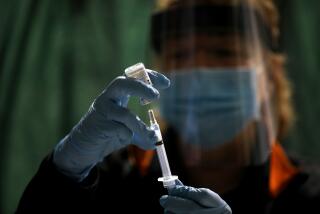Highly allergic on high alert
- Share via
Every few weeks, I hand a prescription for an injection of epinephrine -- the world’s most precious elixir during a major allergic attack -- to at least one allergic traveler. Say, to a person with extreme bee-sting reactions headed somewhere far away (think Serengeti plain, South American jungle or maybe just a big national park) that has plenty of venomous insects and few if any emergency rooms.
Most of the shots are never used, but that’s OK by me. Long ago, a bee almost killed my boyfriend. After that, I got religion about ensuring my patients are prepared for an emergency even if the chances of it happening are slim.
When I witnessed John’s near-death-by-bee, many patients had never heard of anaphylaxis. Today, this medical word for an extreme allergic reaction that can be set off by anything from bee venom to peanuts to penicillin is more familiar. But even today, we doctors still give epinephrine to only a handful of people who might some day suffer anaphylaxis.
And that’s not good.
Back in the 1980s, John and I were budding medical scientists in Boston. (Or, to put it more plainly, overworked, underpaid lab rats.) On a rare weekend off, John suggested we attend his family’s annual Ukrainian summerfest in upstate New York. Aaah, I thought, that’s more like it. A rustic camp in the woods. Grilled kielbasa. Dancing under the stars.
John lay napping in the passenger seat of my aging Saab, his midriff peeking out beneath a polo shirt, while I motored up a verdant highway.
Suddenly, a tiny whine pierced the air. John slapped his side.
“Did a bee just sting me?” he asked hoarsely, still half-asleep.
“Beats me,” I replied. “Haven’t seen one.”
“Well, I think it did,” he replied, suddenly upright, his eyes big with fear. “And I also think I’m allergic.”
He lifted his hand and showed me a dying bee lying atop a brilliant hive on his left lower abdomen. Before our eyes, the hive grew from the size of a silver dollar to a clenched fist.
Minutes later, the skin around the livid patch exploded in more baby hives. Before my eyes, John’s eyelids and lips started to swell and his cheeks bloomed red.
“Oh, God,” he moaned. “I feel awful.”
My heart was racing. Pedal to metal, I scanned the empty roadside. “Please,” I thought, let there be a hospital sign! A few miles later came an answer to the prayer: that blue symbol. I gunned the exit ramp, ran a couple of stop lights, screeched the car to a halt in front of the ER entrance. I leaped out and dashed through a sliding door.
“Bee sting! Come quick!” I yelled. An emergency room orderly followed me back to the car and pulled John -- his face now bloated, his breaths wheezy -- into a wheelchair. A nurse injected epinephrine. Another began administering IV fluids and oxygen.
John complained of an itchy, swollen tongue and mouth. Antihistamines and steroids were added to his mix of drugs. An anesthesiologist was called in case his airway began to close off, which would necessitate inserting a breathing tube down his throat.
John dodged that last, painful bullet. By afternoon’s end, his breathing had eased, he could raise both of his eyelids and we were back on the road, happily anticipating kielbasa and music under the stars once more.
In an allergic emergency, epinephrine (also called adrenaline) is the principal counterattack to a dangerous chemical volley released by human mast cells. Ask any allergy specialist and she or he will tell you that patients at risk for anaphylaxis should do three things:
1) Learn to self-administer epinephrine;
2) Carry a pre-filled epinephrine syringe, especially when far from home;
3) Wear a MedicAlert necklace or bracelet.
But some highly allergic individuals don’t know that epinephrine shots are available for self-use, and some doctors are reluctant to prescribe them, fearing their patients will use them unnecessarily and run the risk of side effects such as a runaway heartbeat or a sudden spike in blood pressure. But the fact is, during anaphylaxis, such byproducts of treatment pale in comparison to the potentially lethal events if the allergic reaction isn’t halted.
Today, some schoolchildren allergic to certain foods, stings or medication even carry epinephrine shots in their backpacks.
When they’re teenage drivers, they should also stash epinephrine in the glove compartment -- and rehearse what they should do and how to stay cool should they ever meet a bee while cruising down the highway at 65 mph.
We should all heed that last piece of advice, for that matter. According to experts, the yearly toll of bee-sting-related deaths -- roughly 100 in the U.S. -- is far less than the number of crashes that occur when a panicked motorist finds one of the insects in the car.
--
Dunavan is professor of medicine and infectious diseases at the David Geffen School of Medicine at UCLA.
More to Read
Sign up for Essential California
The most important California stories and recommendations in your inbox every morning.
You may occasionally receive promotional content from the Los Angeles Times.













